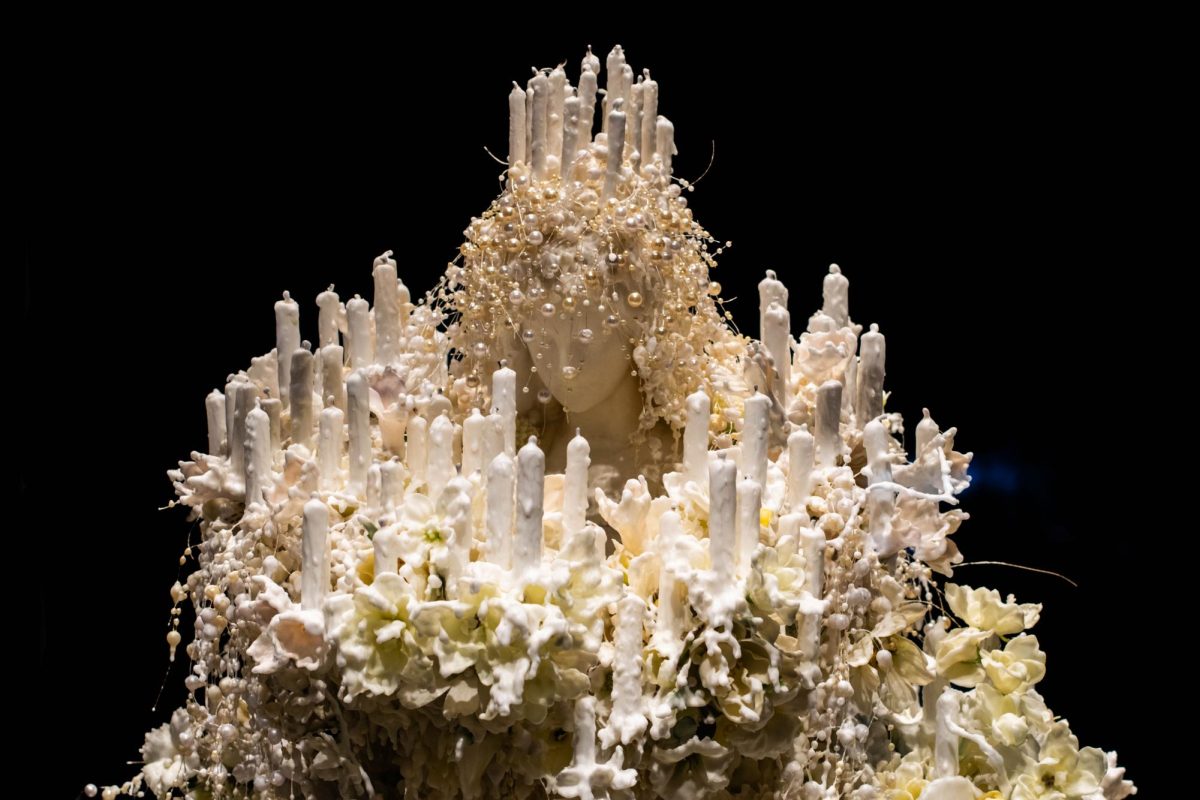Hidden between the walls on the first floor of the Chazen Museum of Art, a statue is paused with an obedient heavy bowed head and closed eyes, her neck protruding from a garden of white wax flowers and candles. It is the face of Zelda Fitzgerald, writer and wife of F. Scott Fitzgerald.
On April 23, 1939, Fitzgerald entered a psychiatric facility a few miles outside Paris — her life forever becoming a routine of electroshock therapy and insulin shock treatments.
Today, New York contemporary sculptor and photographer Petah Coyne brings back the story of her life through her wax statue.
Zelda’s wax statue, with her calm charm, stands at the entrance of Coyne’s new exhibition at the Chazen, “How Much a Heart Can Hold.” The exhibit appreciates Zelda’s contribution to history and serves as a remembrance of her legacy — one of the many hidden stories shared through Coyne’s work.
Best known for her work with unorthodox material such as silk flowers, human hair, wax and scrape metal amongst others, Coyne’s exhibit presents a mixture of hope and darkness to Madison, showing both the suffering and happiness life is capable of inflicting along with the frailty and power of the human will.
Coyne discussed the complexities of Zelda’s life.
“It was a tragedy,” Coyne said. “She helped [Scott] so much and he would not have become the writer he is today without her. And there was so much love between them. She was a flapper and she was so glorious and had an aroma and was beautiful. Her life became a tragedy.”
UW junior Kayley Bell said viewing the exhibit was like being sucked into the darkness.
Another UW Student, Kennedy Webb, shared her views on being swept by the fleeting vivacity of the work and the ambiance of its power.
“I really like the contrast between the white and black hanging from the walls and also the how there is that one escaping squirrel amongst all those powerful peacocks,” Webb said. “It really fascinates me. It is as if I can sense good and evil.”
As a young child, Coyne traveled to many different parts of the world. Her father was in the military which took her all over the U.S. and other countries like Japan and Indian. Today, she shares her experience and the cultures she has witnessed through her art.
One piece carrying importance for Coyne sprawls across the center of the exhibit. Thick batches of hair flow on the floor and amass into a lady whose face and body cannot be seen.
“There is something haunting about it. I don’t know what it is, but it feels really sad and terrifying.” Bell said.
It is a sad but proud portrayal of the sacrifice and pride of 13th century Japanese women who cut their hair to build a temple.
“In Japan, when women cut off their hair, it is giving up their position in the household, their sexuality and their beauty,” Coyne said. “They usually give it when their husband dies but they did it to make a temple. A whole generation of women in their 30s and 40s cut their hair and they were proud of it.”

The hair was used to make ropes to carry wood from the forests. One can still discover it if they go to Kyoto, Japan. Coyne shared her astonishment on discovering the hair’s unremovable mark on earth.
“I had a vision with these braids having bows and beautiful things and I wanted to see it. I looked everywhere in the temple but I couldn’t find it. This monk saw me looking for two hours, and he comes up to me. I did not speak Japanese, so I drew a sketch in my sketchbook. He takes me over and shows me this big flexiglass coil of hair, but it did not look like hair. It was perfect rope,” Coyne said.
Forty years later, when all the women who contributed died, the temple’s congregation would separate due to conflict. The division would lead the south of Kyoto to disperse further away, forcing them to build another temple of their own.
The piece is intended to make us think about our failure to learn from history and our destructive actions, according to Coyne.
“The next generation of women had to cut their hair. It so sad that we learned nothing. We continue to do this. We cannot have another war,” Coyne said.
Another piece which stands out in Coyne’s exhibit is her installation made from a shredded 1950s Airstream trailer. It’s inspired by her time lecturing at Yale, where her students took her to their favorite place — a wrecking yard.
On watching the Airstream trailer present during that time, she was captivated by the process but was told it would cost $100,000 to shred. With the help of a government grant, she was able to see it happen.
The trailer now sits in Coyne’s exhibit as an installation inspired by Yasunari Kawabata’s “The House of the Sleeping Beauties,” according to Isthmus.
Coyne likes to use her art to show cultures and experiences of what it means to be alive and both the happiness and suffering which comes with it.
“How Much a Heart Can Hold” makes the spectator ask themselves questions about their own actions and that of the world while experiencing the various cultures we have to see. It tells the stories hidden in the passage of time through innovative material.
“It does not matter what I made [the piece] to be. What matters is that the artist puts the heart into it and then the audience see it with their own and what they see and feel is important,” Coyne said.
The exhibition will remain open to the public from Sept. 9 to Dec. 23.



